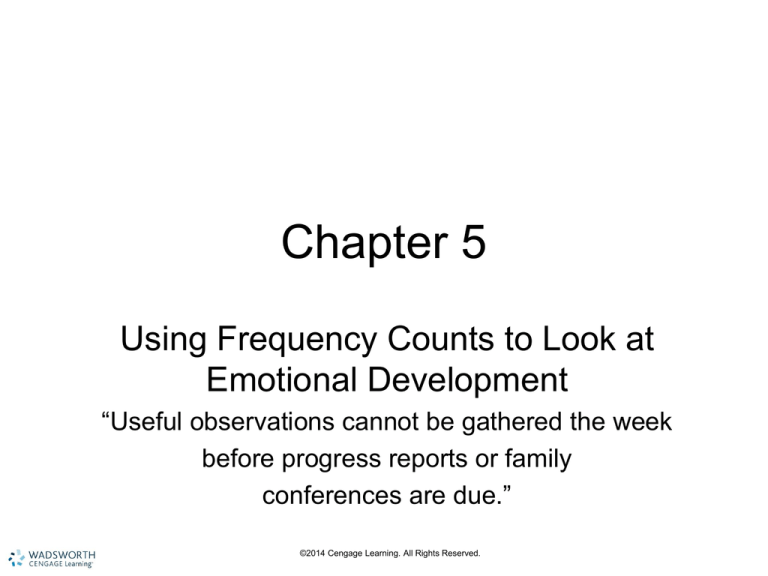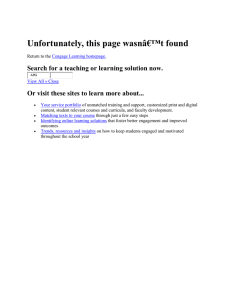
Chapter 5
Using Frequency Counts to Look at
Emotional Development
“Useful observations cannot be gathered the week
before progress reports or family
conferences are due.”
©2014 Cengage Learning. All Rights Reserved.
FREQUENCY COUNTS
• Measure any action or behavior that
occurs frequently in an individual, a class
or group
• Closed method – No details recorded
• Measure the outcomes after implementing
a strategy
©2014 Cengage Learning. All Rights Reserved.
Frequency Counts
©2014 Cengage Learning. All Rights Reserved.
Uses of the Frequency Count
Advantages
• Quick to record
• Quantitative
measurement
Disadvantages
• Details are not
recorded
• Only measures one
behavior, highly
selective
• Allows the recorder’s
bias to enter the
recording
©2014 Cengage Learning. All Rights Reserved.
What to Do With It
• If it is focused on a child, it can measure the
effects of an intervention strategy
• It can be filed in the child’s folder
• If it is on the whole group it can be a pre- and
post-measurement of an intervention
strategy, filed in the Class File rather than
individual folders
• Shared with child, family, group as
appropriate
©2014 Cengage Learning. All Rights Reserved.
LOOKING AT
EMOTIONAL DEVELOPMENT
Core emotions
• Joy
• Anger
• Sadness
• Fear
Temperament (nature)
Socialization of emotions (nurture)
©2014 Cengage Learning. All Rights Reserved.
Joy, Love, Happiness
– Relationships of trust – Closely aligned
– Observing the absence of joy
• Temperament?
• Maternal depression?
• Sign of abuse or neglect?
– Failure to thrive – Physical condition or
developmental regression from absence
of nurturing
– Resilient child – Overcomer
©2014 Cengage Learning. All Rights Reserved.
Anger and Aggression
©2014 Cengage Learning. All Rights Reserved.
Challenging Behavior
• “Behavior that interferes with learning or
social engagement”
• Intervention begins with assessment
based on typical developmental behavior
• Prevention of more serious social
problems later
• Bullying – Anti-social, coercive behavior
that sets a pattern of aggression
©2014 Cengage Learning. All Rights Reserved.
Fear and Shyness
• Fear and development
– Stranger anxiety
– Nightmares
• Shame, a form of fear
• Shyness
• Children under stress
©2014 Cengage Learning. All Rights Reserved.
TOPICS IN OBSERVATION
The Assessment and Curriculum Braid
Weaving together:
• Child development – Knowledge of all children
• Curriculum – Skill in planning appropriate learning
activities
• Assessment – Observation to know the child intimately
• Teaching philosophy – Approach to teaching
• Documentation – Recording methods and strategies
• Individualizing – Designing learning for each child
• Evaluation – Measuring how each child is progressing
• Reflection – Thinking about the process of teaching
and learning
• Communication – Sharing with child, family, colleagues
©2014 Cengage Learning. All Rights Reserved.
Observing Emotional Development
in Infants and Toddlers
Watch for behavior that gives clues to:
• Sensory integration – Organization of
sensory information dependent on
temperament and the duration and intensity
of stimuli
• Self-regulation – Ability to control reactions
to stimuli and behavior
– Watch for arousal, attention, affect ,and action
©2014 Cengage Learning. All Rights Reserved.
Emotional Competence
• Modeling – Examples of appropriate
expressions of emotions, including anger
and sadness
• Coaching – Giving names to the emotions
the child may be feeling and appropriate
ways to express them
• Contingency – Deciding when to intervene
©2014 Cengage Learning. All Rights Reserved.
Helping All Children with
Emotional Development
• Mental Health Problems in Young Children
– Vulnerable because of developmental stages
• Behaviors that Warrant Concerns
• Emotional Development of Young ELL’s
• Children with Special Needs
– Frustration; difficult behaviors
– Fear by other children or differences
• Helping Professionals
©2014 Cengage Learning. All Rights Reserved.
Standard Related to
Emotional Development
National Association for Family Child Care
Quality Standards for NAFCC
Accreditation (2005)
Part 1. Relationships: The Children with
Each Other
1.21 The provider helps children
understand their own feelings and those of
others.
©2014 Cengage Learning. All Rights Reserved.





